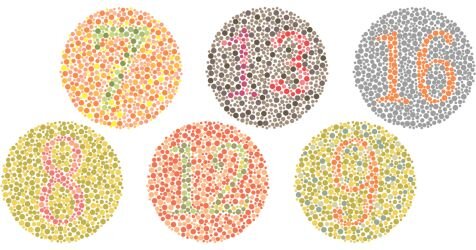Colour Vision
Colour Vision deficiencies occur in 4-8% of males and 0.5% of females. Colour deficiency does not mean colour “blind”. You do see colours – just differently.
Why it happens
Photoreceptors in the retina, known as cones, have light-sensitive pigments to register different colours but if the cones don't have one or more of these pigments, the person is unable to see colours fully.
Of those with colour deficiencies: -

Mapping Colour Vision Deficiencies
Defective colour vision can range from a near to normal ability to distinguish colours, to a high degree of confusion.
Ishihara Plates
This test can be done quickly and is sensitive for screening colour-deficient people but they are not effective in classifying the deficiency. The colours of the numbers and the background are purposely pale and are carefully chosen from hues that are difficult for a colour-deficient patient to distinguish.
The Farnsworth Panel D-15
15 coloured discs must be arranged within the tray to create a continuum of gradually changing hues. Errors can be plotted very quickly on a simple circular diagram to define the nature of the colour deficiency. The test may miss mildly affected people but the relative insensitivity can also be an asset in judging the practical significance of mild degrees of colour deficiency.
In real terms, those who fail the Ishihara plates but pass the D-15 panel will probably not have colour discrimination problems under most circumstances and in most jobs.
Parents should be mindful of subjects their children choose to study during their school and University years
Many careers require perfect colour vision. Among them:
Airline pilots
Jobs that are covered by OSHA
Chemical and Process Engineers
Ship captain
Law enforcement
Electronic and computer industries
Graphic and fine arts/textiles
Everyday difficulties for a colour-deficient person: -
How to match clothing
How to decide on colours for decorating a house
Did you know that Mark Zuckerburg, the creator of facebook is colour blind?
“Blue is the richest colour for me; I can see all of blue”
— Mark Zuckerberg
ChromaGen Contact Lens
In our years of fitting lenses, this one comes close to being the best one for the reaction people have when they realise all the colours they never knew existed.
This contact lens is worn in the non dominant eye so that there is a comparison of contrasts between the two eyes. The lens is named the “X-Chrome” lens because the gene that causes the deficiency is carried on the X chromosome.
Read more about ChromaGen lenses here






